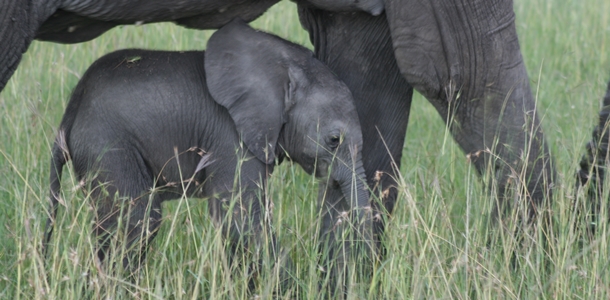With the upcoming talk at the RGS, given by wildlife film-maker and elephant expert Saba Douglas-Hamilton, in mind, one of our directors Robert talks about some of his elephant encounters over the years.
I love elephants. Whenever I’m in Africa checking camps and visiting suppliers I always make time to game-drive and a priority is to see some eles. To me it is Africa. If I’m in Amboseli it’s one of the most iconic images of the continent, elephants standing before a snow-capped Kilimanjaro. If I’m Tarangire, I love sitting watching a large herd slowly wend their way through the Park.
Its watching them interact that makes them so special. In the Mara last year with George, one of our most experienced and popular guides, we spent a very amusing 20 minutes watching a young baby, only a few weeks old, pester its mother for a drink of milk. She was having none of it but was finding it very hard to stop her offspring who was small enough to walk under her and between her legs. Eventually she gave in and he got his drink.
Over the years I’ve also been charged several times by elephants. Happily the oldest of these aggressors was probably about a year old and had they hit the vehicle they would have bounced off. Heads shaking and nodding, trunks waving, they’ve left the safety of mum and head at high speed towards us. After a few metres they usually stop, give us a good stare to check if there’s been any reaction. When they see none, they glance over their shoulders, realise mum is now quite a way away and beat a rapid retreat. All good practise for their adult years.
Sometimes you get lucky, although the better the guide the luckier you tend to get. You’re parked up, quietly watching a family herd and they slowly envelop the vehicle as they graze closer. It’s extraordinary to be so close that you can see the texture of their skin, almost count the bristles on their bodies and hear them gentle talk to each other through quiet rumbles. Watching them grasp grass with their trunks, sometimes using their toes nails as a scythe to cut through the tougher stems.
I was once with my family at Shamwari, a lovely private reserve in the Eastern Cape of South Africa. We were surrounded by a family and a young female stopped by our vehicle. You could see her looking at us and her gaze settling on my 7 year old daughter. Very slowly she raised and extended her trunk until it was only a few centimetres from her face. It gave a gentle sniff, moving gently up and down her body. It repeated this several times before moving on. My daughter, 10 years later, still talks about this, commenting that at no point was she scared or worried, just that she’d wanted to shake its trunk as a greeting.
The most interesting thing I’ve seen elephants do was also one of the most puzzling. Having got out of a marsh in Amboseli, an elephant spent several minutes getting a stick carefully positioned. It then stood on one end and used a pointed bit on the other end to clean mud from under its toenails.
Everybody loves elephants. Tragically this hasn’t stopped the greatest crisis that they have ever faced developing. Poaching for ivory is at the greatest level it has ever been, driven by the demand for ivory in Asia. Tanzania recently reported that it had lost over 40% of its elephant population between 2010 and 2013 and this is a country with designated National Parks, rangers and a strong conservation presence. In countries like the Congo it doesn’t bear thinking about what has happened to the elephant population where there is little anti-poaching infrastructure. Near annihilation is a realistic and sobering assessment.
That is why Real Africa has chosen the ‘Save the elephants’ charity as its partner charity for its 15th anniversary year. The work they do, increasing our understanding of elephants, is crucial if they are to survive. This research, mostly done in Samburu National Park in Kenya, is applicable to help the elephant population across the continent.
The talk by Saba on the 8th October at the Royal Geographical Society will raise funds with the proceeds of the ticket sales all going to the charity. We will also be promoting ‘Save the elephants’ at all the consumer shows we display at throughout the autumn and spring, raising awareness and funds. We are delighted to be working with such a dedicated and passionate group of people. Hopefully it will go a small way to ensuring that when my daughter takes her children out on safari in years to come, they too will have the chance to be sniffed by an elephant.

